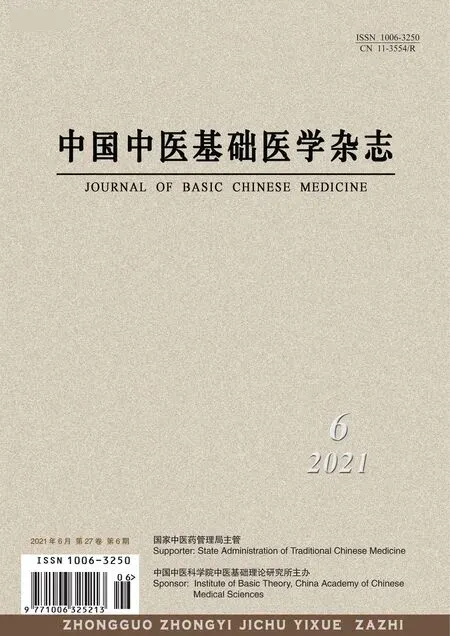论中医典籍中“虚实”的英译——以《黄帝内经》译文为例❋
2021-03-28沈晓华
沈晓华, 刘 昕
(中南民族大学外语学院, 武汉 430074)
世界卫生组织(WHO)关于“虚实”的标准化译名deficiency and excess契合与病证相关的“虚实”表述,并不具有普遍适用性。而中医典籍英译中的“虚实”就涉及包括病证在内的多个层面的涵义。
1 与空间相关之“虚实”
从“虚实”的词源可知,古人对于两词的认知基于物体在一定范围内有无的空间概念。具象的空间画面是“虚实”在描述物体时获得的首个衍生义项,而中医典籍关于五脏六腑运化功能的论述就涉及“虚实”的空间概念。
例1 :六腑者,传化物而不藏,故实而不能满也。所以然者,水谷入口,则胃实而肠虚;食下,则肠实而胃虚(《素问·五脏别论篇》)。
译文1: The so-called Six Fu-Organs only transport and transform food and will not store it up. That is why they are always Shi (to be filled up) but not Man (full). This is due to the fact that when food is taken into the stomach, the stomach is full, but the intestines are empty. When the food is transported downwards, the intestines are full but the stomach is empty[1]150.
译文2: The six fu organs receive the food and digest, absorb, and transport it, passing it on. They are often full, but still do not store. Food enters the mouth and proceeds to the stomach. The stomach is now full, but the intestines are empty. The foodstuff passes down, filling the intestines. Now the stomach is empty[2]46.
分析:此句是《黄帝内经》关于六腑传化功能的论述。六腑的特点即文中所说:实而不能满,这与六腑均为中空腔体的构造有关。因内质中空,六腑在消化过程中“传化物而不藏”,即六腑虽会被水谷精微所填充,但不会长时间使其贮藏于腔内,因而不会因水谷精微累积而维持“满”的状态。译文1用拼音加文内注释译“实”为Shi (to be filled up),体现“被填充”的动态过程,而“满”则译为full,即静态的充满之意。但译文1在其后的“胃实而肠虚”及“肠实而胃虚”中却选择表静态的full来译“实”,与filled up不相一致,且与之前“满”的译词相同:既然“实”和“满”在此句中各有分别,均用full来译二者实为不妥。从原文“实”与“虚”并立而论的情况看,译者大概是想用full体现出与empty的相对关系,但却疏忽了前后译文矛盾的问题。译文2的“实”也选用了full和fill两个词,但却不译“满”字,转而改变原文结构,将“不藏”(do not store)置于句末,与“实”相对。如此处理之后,前后文虽然通达但却是明显的漏译。此句中,水谷精微因六腑的通降而处于动态运行之中,胃实或肠实也都是动态变化的,因而“实”的译文不妨统一为表动态的filled,以区别于表静态的full(满);同时,该词亦能与empty(虚)构成空间状态上的对立关系。
2 与哲学相关之“虚实”
“虚实”空间被抽象化后旋即进入哲学体系,以诠释自然界的运行规律。中医典籍关于自然、宇宙及养心调神的许多认识便源于此,其中的“虚”字就时常带有一定的哲学观。
例2:太虚寥廓,肇基化元,万物资始(《素问·天元纪大论篇》)。
译文1: It says that the borderless heavens is the primary source of transformation of all things and the beginning of everything[1]733.
译文2: It states that in the vast void of the universe exists the primordial origin of life[2]236.
例3:地为人之下,太虚之中者也(《素问·五运行大论篇》)。
译文1: The earth is located below human beings and in the universe[1]753.
译文2: The earth is below man and within the Great Void[3]49.
分析:“太虚”出自道家学说。例2中的译文1和译文2在译“太虚寥廓”时均采用转译法:译文1转表语“寥廓”为定语borderless,译文2则转译为定语vast,而“太虚”的译文却大为不同:译文1理解为heavens(天空),译文2理解为void of the universe(宇宙的空无)。译文1所采用的heavens是否就是“太虚”在文中的含义呢?相较译文1,译文2选择更为直译的void(虚空),但特指宇宙之虚空,译者将直译与意译相结合点出观察的客体“宇宙”(universe),但又不予之以中心词地位,转而使其修饰“虚空”,试图达到形意兼顾的效果。其实,例2中的原文出自古代最早研究天文的书籍《太始天元册》,可见“太虚寥廓”应指古人抬头仰望到的星空宇宙辽阔无边。例3中岐伯曰:“地为人之下,太虚之中者也”,其后文是:“帝曰:凭乎?岐伯曰:大气举之也”,在文本内印证了《黄帝内经》中的“太虚”就是今天“宇宙”的概念:地球因大气托举而悬浮于宇宙之中[4]707,因而“太虚”即为宇宙本体,当直接译为universe。例3中的译文2则按字对译为Great Void,保留了古汉语的形式。
3 与身体状态相关之“虚实”
在日常话语中,“虚实”往往作为概略性词汇描述人的身体状态;而在中医领域,其关于身体状态的描述又往往与气血精津液相关。
例4:以身之虚,而逢天之虚,两虚相感,其气至骨,入则伤五脏(《素问·八正神明论篇》)。
译文1: If a weak body is attacked by the Xu (Deficiency) of the heavens, the pathogenic factors will deepen into the bones and damage the Five Zang-Oragns[1]343.
译文2: If a patient is already deficient, and is then invaded by the pathogens of the natural world, the condition will be compounded and the patient will suffer tremendous injury[2]104.
分析:此句论及虚邪致病对身体的危害。身之虚,即为身体的虚弱状态,译文1译作weak body,契合原文;译文2译作a patient is already deficient,显然是取“不足”之意,但“不足”之虚是指人体中气血精津液的不足状态,而非人的“不足”或“欠缺”,因而以deficient直接描述人是不妥当的;同理,常见的“肾虚”一词若翻译成deficiency of kidney岂不是说“肾有缺陷”?正确译法应当是deficiency of kidney Qi,即肾气不足。天之虚是指自然界的虚邪,是由于人体正气不足而侵入人体引致疾病的邪气,译文1的Xu(Deficiency)并未译出外界之邪,译文2则采用释义法直接点出外邪“自然界治病因素”(the pathogens of the natural world);结合两则译文,“天之虚”不妨译为Deficiency-Evil (pathogenic factors) from the natural world。两虚相感,是指“身之虚”与“天之虚”相互接触、相互影响。由于前面已提到“身之虚”受“天之虚”侵犯,则“两虚相感”是相同意思的另一种表述,因而译文1和译文2均省略不译。但“相感”是古代朴素哲学中的重要概念,亦反映了中医“同气相求”的理论,故而译出为好。基于此,“以身之虚而逢天之虚,两虚相感”可完整译为:If a weak body is invaded by the Deficiency-Evil (pathogenic factors) from the natural world, that is to say, the weakness of the body is in contact and interaction with the Deficiency-Evil。
例5:月郭满,则血气实,肌肉坚;月郭空,则肌肉减,经络虚,卫气去,形独居(《素问·八正神明论篇》)。
译文1: When the moon is full, blood and Qi [in the body] are superabundant and the muscles are strong; When the moon shines no light, the muscles become weak, the Jingluo (Channels and Collaterals) are empty, Weiqi is deficient and only the physical form of the body alone exists[1]341.
译文2: At the height of full moon, the blood and qi are full and the muscles become strong. When the moon wanes, the channels and collaterals become empty of blood[2]103.
分析:该句论及月相对人体气血运行的影响,是身体在不同月相下的生理状态。前后两个分句分别包含两组相对的形容词:“满、实、坚”及“空、减、虚”。译文1分别用“full, superabundant, strong”及“shines no light, weak, empty”与之对应;译文2则采用“full, full, strong”及“wanes, 省去不译, empty of blood”。月相的满与空即是月的圆缺状态,译文2“full, wanes”准确地体现了月的形态变化。“血气实”反映气血在人体内量的状态,即气血的充足,译文1的 superabundant和译文2的full都能体现气血在量上的充盈,但superabundant较full更能表达出气血的富足和有余,且避免了译词full的重复使用。“肌肉坚”与“肌肉减”相对,译文1分别用strong和weak体现这层关系。在译“经络虚”时,两则译文均择取“虚”字的空间概念empty,符合经络作为气血精津液循行通道的特点,译文2明确指出其中运行的是blood,从而将“虚”具体化为empty of blood(血的缺失)。此译法不免有些偏颇:因为除血之外,气的运行也受到月缺的影响,尤其是循行于经脉和络脉中的营气。
4 与病证相关之“虚实”
中医认为疾病的状态有虚实之分,虚就是正虚,实则为邪实。在病态层面,虚的引申义为不足,实的引申义为过剩,也即WHO标准术语中的deficiency和excess。关于这层理解,《素问·通评虚实论篇》有明确的表述:“邪气盛则实,精气夺则虚。”
例6:阴阳上下交争,虚实更作,阴阳相移也。阳并于阴,则阴实而阳虚,阳明虚则寒栗鼓颔也(《素问·疟论篇》)。
译文1:This is due to combat between Yin and Yang in the upper and lower, alternate appearance of Xu (Deficiency) and Shi (Excess), and alternation of Yin and Yang. When Yang merges into Yin, Yin becomes Shi (Excess) and Yang becomes Xu (Deficiency). If Yangming Channel is Xu (Deficiency), the patients will feel chilly with bulging cheeks[1]433.
译文2:This is due to the pathogen and the body battling from bottom and top. There is also a great fluctuation between deficiency and excess. And as the body's yang is overcome by the pathogen, it creates an imbalance of excessive yin. When the yang qi is deficient in the yang-ming channel, there will be chills and shaking, even to the point where the lower jaw trembles[2]134.
分析:此句以阴阳虚实的变化论及疟病特点。“虚实更作”指虚实的交替出现,是正气不足与邪气过剩的相对变化过程,译文1和译文2均择取deficiency和excess,并无疑义。“阴实阳虚”是指身体内部的阴邪过剩而阳气不足的邪盛正虚之相。译文1过分直译,没有根据语境将“阴邪”“阳气”译出,因而大大减损了“阴实阳虚”的医学内涵。译文2则试图通过解释性翻译点出其中的病机;译者认为阳虚而有邪气制阳,以致体内阴气过剩。然而原文中,阴实和阳虚是并列关系而非因果关系,导致“阴实而阳虚”的成因是阳气并入阴分。基于此,“阳并于阴,则阴实而阳虚”可改译为The entry of Yang Qi into Yin phase results in a condition that Yin-Evil Qi (pathogenic factors) inside the body is excessive and Yang Qi is deficient。“阳明虚”指六经之一的阳明经气虚,译文1将阳明经作为主语直译显然不妥,译文2则符合医学逻辑,言指阳明经中气的不足状态。
例7:所谓重实者,言大热病,气热脉满……脉气上虚尺虚,是为重虚(《素问·通评虚实论篇》)。
译文1:The so-called Double Excess refers to severe febrile disease marked by fever due to vigorous Qi and fullness of the pulse……The so-called Chongxu (Double-Deficiency) means the Deficiency of the pulse, Qi and Chi (Cubital Skin)[1] 371,375.
译文2:Superexcess points to conditions of high fever and fullness and excess of the pulse……superdeficiency includes deficiency of channels, deficiency of qi, and deficiency at the chi position[2]110,111.
分析:此句是《黄帝内经》对“重实”和“重虚”的定义。从字面来看,重实和重虚意为实上加实和虚上加虚,是说实或虚的状态呈叠加效应。译文1用double excess和double deficiency直译出“重”的本义,译文2取实或虚的程度,意译为super。相较而言,译文1在语义上反映了实上加实和虚上加虚术语的构成特点,形意兼顾,且后文所言“气热脉满”正是2种并存的热邪实证之相,正应“重实”之说;“脉气上虚尺虚”也是说气虚和脉虚二者并存,并可切到尺部虚脉,正应“重虚”。两则译文所言“大热病”也有不同。译文1为severe febrile disease marked by fever,译文2为conditions of high fever。据《素问·热论篇》:今夫热病者,皆伤寒之类也,可见热病属伤寒。译文1将伤寒病名译出实得原文要义;译文2只译高热病状,未将其视为病名,更未点出伤寒,译文留于浅层。
5 与脉象相关之“虚实”
自《难经》始,历代医家大多遵循“独取寸口”的脉诊法,降至李时珍的《濒湖脉学》,更将脉象分为27种,虚脉和实脉便是其中常见的2种。中医典籍中的虚实脉象译名繁多,虚脉译名有deficient pulse, weak pulse, feeble pulse, hollow/vacuous pulse等,实脉译名有excessive pulse, strong/forceful/powerful pulse, replete pulse等。
例8:春脉者肝也,东方木也,万物之所以始生也,故其气来,软弱轻虚而滑,端直以长,故曰弦,反此者病(《素问·玉机真脏论篇》)。
译文1:The pulse in spring is related to the liver which pertains to the east in the five directions and Wood in the Five-Elements. Since spring is period in which all things in nature begin to grow, the pulse in spring appears soft, weak, slippery, straight and long. That is why it is called Xian (taut or wiry). The state of the pulse contrary to it is morbid[1]241.
译文2:In spring the pulse should be slightly wiry. Its quality is soft, light, slightly hollow, and slippery, straight but long[2]76.
分析:此句描述春季脉的特点,译文1将脉之“轻虚”译作weak,译文2译作slightly hollow,反映出译者对虚脉的不同理解。《濒湖脉学》云:虚脉浮大而迟,按之无力,芤脉浮大,按之中空[5]15。可见,取“虚”之“空”义将“虚脉”译为hollow/vacuous pulse无法使之区别于芤脉。从后世对脉诊的归纳可知“虚脉脉势软弱,三部久候皆无力,是一切无力脉的总称”[6]111,因而“无力”是虚脉的最主要特征。作为“虚弱无力”这一类词的统称,weak指称虚脉较为合适,而此类脉中的细脉、弱脉、微脉则可分别译为thready pulse, feeble pulse, faint pulse。如前文所述,deficient指体内气血精津液等物质的不足,但pulse并非这些基本物质,而是人体的生理活动现象,故“虚脉”不应当译作deficient pulse。
例9:胃脉实则胀,虚则泄(《素问·脉要精微论篇》)。
译文1:Strong Stomach-Pulse indicates distension while weak Stomach-Pulse indicates diarrhea[1]211.
译文2:If the stomach pulse is excess or full, there is a stagnation and one will find distension in the epigastrium. If the stomach pulse is weak, there is a deficiency of stomach qi and one is unable to process the food. This will result in diarrhea[2] 67.
分析:此句是关于诊得胃脉的病理情况。译文1将“胃实脉”译作strong Stomach-Pulse,译文2译作the stomach pulse is excess or full。《濒湖脉学》云:浮沉有力为实[5]15。后世总结实脉:脉势满实,三部九候皆有力,是一切有力脉的总称[6]111。可见,实脉的特点是“有力”。因而英译“实脉”当从表“有力”的词汇中择取。forceful在《牛津高阶英汉双解词典》的释义为of opinions, etc expressed firmly and clearly so that other people believe them[7]818,其表达的“有力”是指话语或观点的说服力强;powerful的释义为having great power or force; being able to control or influence people and events[7]1600,其“有力”是说力量的强大或影响力巨大;strong除具备forceful和powerful的上述语用含义外,也特指“of a natural or physical force having great power[7]2071”,即用以描述自然力或物理力的强劲。Pulse是一种人体脉搏的振动(vibration),属于自然力或物理力,所以与pulse最佳的语用搭配词应为strong。
6 与治法相关之“虚实”
“虚实”常用于治法的表述,如“虚者实之,实者虚之”就是名词活用作动词表治法的情况。此类“虚实”的英译当结合原文译出具体的治法,以实现译文的交际功能。
例10:刺实者须其虚,刺虚者须其实(《素问·宝命全形论篇》)。
译文1:Reducing techniques are used to deal with Shi (Excess) and reinforcing techniques are used to deal with Xu (Deficiency)[1]337.
译文2:When treating deficient conditions, use the tonification method. When treating excess conditions, use the sedation method[2]102.
分析:此句论及针刺治疗虚证和实证的方法。“刺实者”中的“实”为实证,“刺虚者”中的“虚”为虚证,可分别译为Excess-syndrome和Deficiency-syndrome。译文1只译“虚实”二词,未根据语境译出证候;译文2译出证候,但择取conditions,虽易为读者理解,但与中医“证”的概念有所出入。从针刺手法使用的不同来看,“须其虚”和“须其实”中的“虚实”当指不同手法的针刺可以实现不同治法。《灵枢·小针解》云:“所谓虚则实之者,气口虚而当补之;满则泄之者,气口盛而当泻之也”[8]54;而《灵枢·通天》所言“实阴而虚阳”也是指补阴而泻阳之法。由此可见,针刺治疗时的“虚实”法就是八法中的“补法”和“泻法”。译文1将“虚”法译为reducing techniques,“实”法译为reinforcing techniques;译文2分别译为sedation method和tonification method。两则译文均采用“具体化”译法,将“虚实”在语境中的“补泻”二法译出。《素问·刺志论篇》从针刺角度论虚实说:“夫实者,气入也;虚者,气出也”[8]594,所以针刺时的“虚实”法调节的是气的流动和出入。译文1所使用的reducing和reinforcing表达的正是对气多少的调节,在医理上是非常准确的,而译文2的sedation和tonification侧重于本草治疗中的补泻法,不适合以调气为主的针刺治疗。
